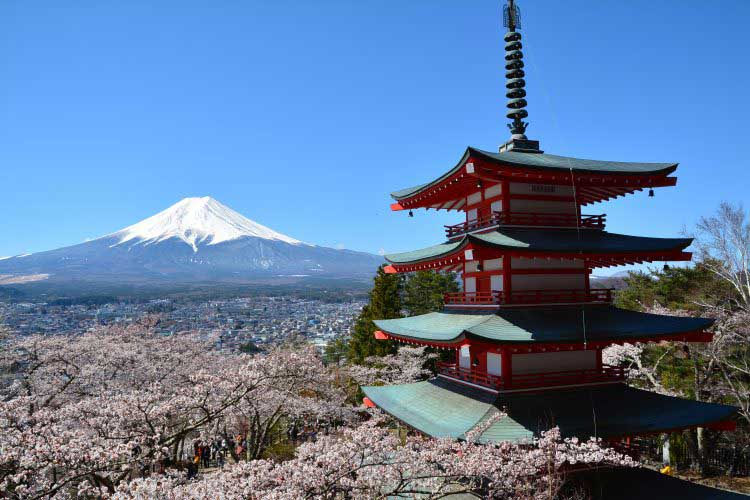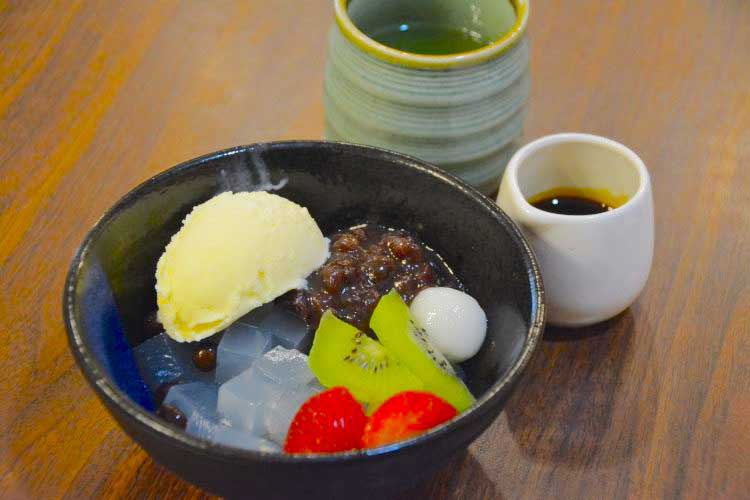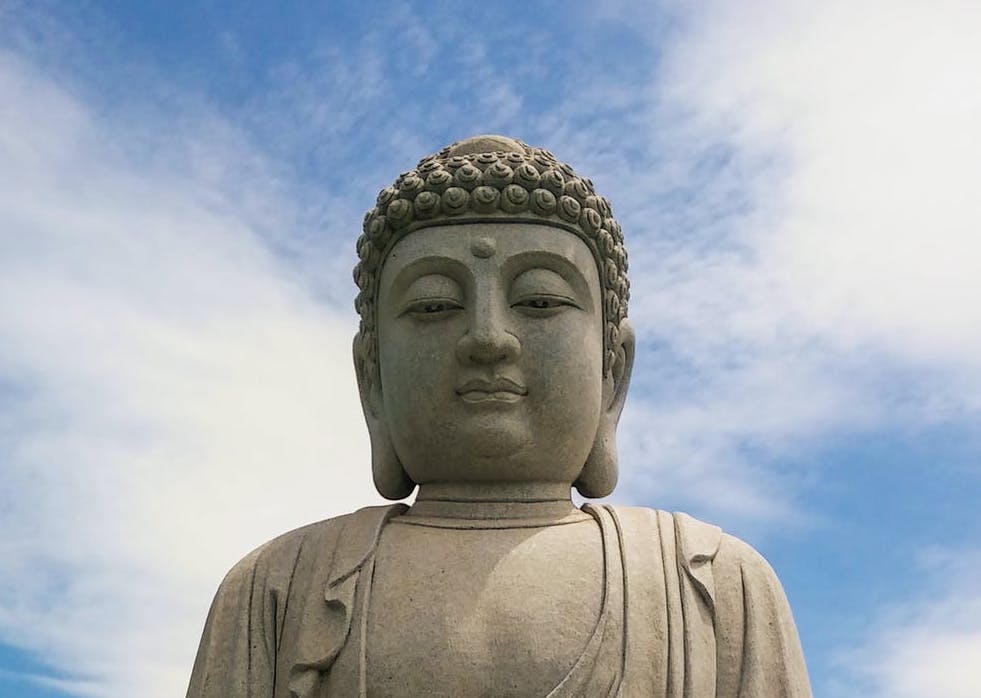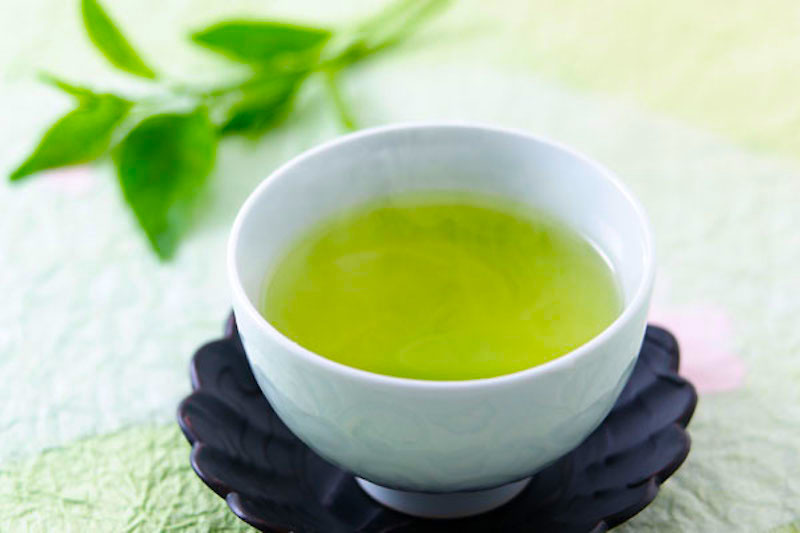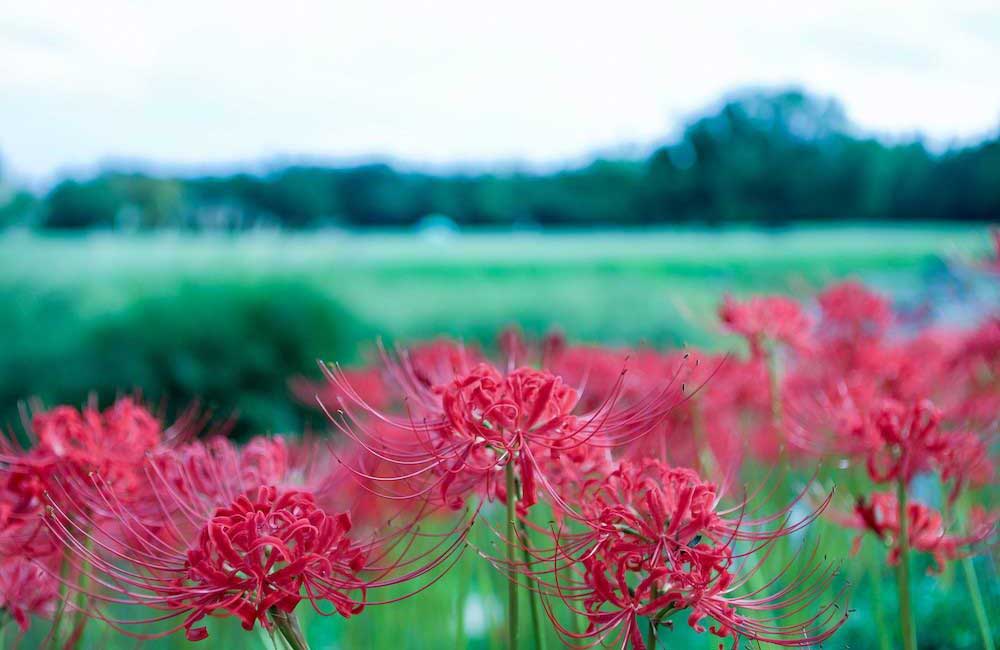
お盆とお彼岸。日本においては「お墓参り」や「先祖供養」として非常に身近なものですが、時期だけでなく、起源や意味にも違いがあります。
今回は、お盆とお彼岸について、英語で説明する表現をご紹介していきます。
ご興味のある方は、当サイトで 英語クイズ(5000問) を出題しておりますので是非ご覧ください。
目次
お盆 / Obon
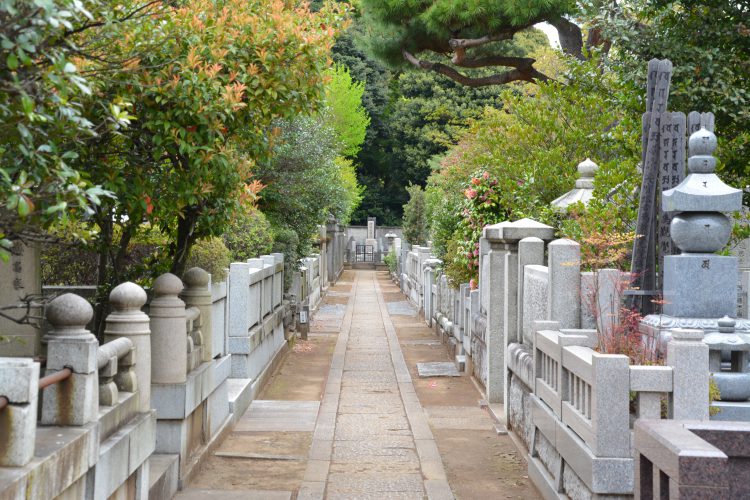
「お盆」とは、日本の夏季において、古くからある祖先崇拝の精神と仏事の「盂蘭盆(うらぼんえ)」が結びついた行事で、仏となった先祖たちが家族に会いに来てくれるといわれています。
かつてお盆は、旧暦の7月13日から7月16日でしたが、明治時代に日本は新暦となり、現在では8月13日から16日までの4日間が一般的ですが、気候や農繁期などの理由から、旧暦に行っている地域もあります。
12日までにご先祖様のお墓のお掃除を済ませ、そしてお盆の1日目である8月13日は「迎え盆」といわれ、お盆のためのしつらえをします。
玄関の外で迎え火を焚くか盆提灯を吊るして、ご先祖様が迷わず家に来られるよう目印とし、盆棚(精霊棚)を設置してナスやキュウリなどでつくった精霊馬を飾り、お墓参りをしてご先祖様をお迎えする準備をします。
そしてご先祖様を家に招いて、ごちそうをお供えしておもてなしをします。最終日である「送り盆」には送り火を焚き、ご先祖様が帰っていくのを見送ります。
・先祖:ancestor
・霊魂:spirit
・供養する:(hold) memorial sevice
・風習:custom、tradition
・お墓:grave
・墓地:graveyard
・身内、親族:relatives
・お経:Buddhist sutra
・仏壇:Buddhist altar
・お供え物:offering
Obon (or just Bon) is a Buddhist event where the traditional custom of ancestor worship became tied up with the “Urabon-e,” a Buddhist festival.
(お盆とは、日本の伝統的な祖先崇拝の風習と、仏事の「盂蘭盆会(うらぼんえ)」が結びついた行事です。)
Obon is a Buddhist festival for honoring the souls of ancestors, which are supposed to be visiting on August 15.
(お盆とは、8月15日に訪れる先祖の魂を供養する仏教のお祭りです。)
Obon is an abbreviation of “Urabon-e.”
(お盆は「盂蘭盆会」の略です。)
Obon is a Japanese Buddhist custom to honor the spirits of one’s ancestors.
(お盆とは、先祖の霊を敬う日本仏教のしきたりです。)
Obon is an annual Buddhist event commemorating one’s ancestors.
(お盆とは、故人を偲ぶ仏教の年中行事です。)
Originally, the spirits of ancestors were thought to return home during the period of Obon.
(もともと、お盆の期間は先祖の霊が家に帰ってくると考えられていました。)
It is believed that each year, during the Obon period, the spirits of those who have passed on return to this world to visit their families.
(毎年お盆の期間は、先祖の霊がこの世の家族のもとを訪れると信じられています。)
In general, Obon refers to August 13th to August 16th.
(一般的に、お盆は8月13日から8月16日を指します。)
Even though Obon is not a public holiday, obon is considered one of the most important family events of the year in Japan.
(お盆は公的な祝日ではないものの、日本の家族にとって最も大切な行事のひとつとされています。)
Although obon customs vary by region, people light mukae-bi (welcoming fires) to invite the return of their ancestors’ spirits.
(お盆の風習は地域によって異なりますが、迎え火を焚いて先祖の霊を迎えます。)
Obon begins with mukae-bi (welcoming fires) practice, during which people make a small bonfire at the entrances to guide the spirits of ancestors upon their return back home.
(お盆は、先祖の霊を家に導くために、小さな火を焚いた「迎え火」から始まります。)
Obon is a Buddhist event to hold memorial services for ancestors, in which ancestors’ spirits are welcomed with mukae-bi (welcoming fires) and seen off with okuri-bi (sending-off fires) for escorting the spirits of the ancestors.
(お盆は先祖を供養する仏教の行事で、迎え火を焚いて先祖の霊を招き、送り火によって霊を見送ります。)
People visit graves or ask a Buddhist monk to come to their homes to recite sutras.
(お墓参りをしたり、お坊さんに自宅で読経してもらったりします。)
In Japan, there is a traditional custom where people pay a visit to their family’s graves and pray on their memorial days or during Obon and higan week.
(日本では、命日やお盆、お彼岸などに家族のお墓参りをする風習があります。)
Visiting graveyards to comfort ancestors’ spirits is called “ohakamairi.” The word “haka” means “grave” in Japanese.
(お墓にお参りして先祖の霊を慰めることを、日本語で「お墓参り」といいます。haka とはお墓のことです。)
Ohakamairi means to tell their loved ones who have passed away that their family members are well and express thankfulness.
(お墓参りとは、愛する故人に家族の無事を伝え、感謝の気持ちを表すことを意味します。)
People pay homage to their ancestors by cleaning the grave, making an offering to it, calling a Buddhist monk to read a sutra and offering incense sticks to the grave one by one.
(先祖への敬意を込めてお墓をお掃除し、お供え物をして、お坊さんにお経を読んでもらい、順番にお線香をあげてお参りをします。)
During the Obon period, people make a “bon-dana” (bon altar) to make offerings of seasonal vegetables and fruits and to welcome the spirits of their ancestors.
(お盆では、先祖の霊を迎えるために盆棚をしつらえ、旬の野菜や果物などをお供えします。)
In most places, a “bon-dana” (bon altar) on which offerings to the ancestors are placed is set up, and “mukae-bi” (a greeting fire) is lit to welcome the spirits on the first day of Obon.
(一般的には、先祖へのお供え物をのせた盆棚をしつらえ、お盆の初日には迎え火を焚きます。)
During the Obon period, Buddhist monks visit their parishioners’ houses to read a sutra, and people visit their family graves.
(お盆の間は、お坊さんを家に招いてお経を読んでもらったり、家族でお墓参りに出かけます。
On the last day of Obon, okuri-bi (a sending-off fire) is lit to see off the ancestral spirits on their way back to the other world.
(お盆の最終日は、先祖の霊が無事に向こうの世界に帰れるよう、送り火を焚きます。)
When Obon is over, the spirits are usually sent back on their way. The customs followed vary strongly from region to region.
(お盆が終わると、霊を送り返します。この風習は地域によってかなり違いがあります。)
盂蘭盆(うらぼんえ)
盂蘭盆会とは、サンスクリット語で「Ullambana(ウランバナ)」という古代インドの言葉を音写したもので、「逆さ吊り」という意味です。
これは仏教の「盂蘭盆経」に説かれているとされる、目連(マウドガリヤーヤナ)というお釈迦様の弟子の、餓鬼道に落ちてしまった亡き母への供養の伝説に由来しています。
Urabon-e (or Obon) is a Japanese Buddhist custom to welcome and pray for the spirits of one’s ancestors.
(盂蘭盆会とは、先祖の霊を迎えて供養するための日本の仏教行事です。)
Obon is an abbreviation of Urabon-e, which is a transliteration of the Sanskrit word ullambana, meaning “hanging upside down.”
(お盆という言葉は盂蘭盆会の略で、サンスクリット語の「逆さ吊り」を意味するウランバナという言葉を音写したものです。)
Among the Shaka’s disciples, there was one named Maudgalyayana (“Mokuren” in Japanese) who had divine powers.
(お釈迦様の弟子たちの中に、神通力に優れたマウドカリヤーヤナという者がいました。)
Mokuren used his power to see what was happening to his deceased mother, only to discover she had fallen into the hell of Hungry Ghosts and was suffering as if she had been hung upside down.
(目連が神通力を使って亡くなった母の様子を見てみると、母は餓鬼道に落ちて、まるで逆さ吊りにされているかのように苦しんでいることが分かりました。)
Greatly shocked, Mokuren went to the Shaka and asked how he could release his mother from this misery, to which the Shaka replied, “After you have finished your rainy season practices, on July 15th, make offerings to all Buddhist monks and pray for your mother.”
(ショックを受けた目連は、釈迦のもとへ行き、どうすれば母を救えるか相談すると、釈迦は「雨期の修行が明けた7月15日に、全ての僧侶たちにお布施をし、お母さんのために祈りなさい」と答えました。)
Mokuren did as Shaka instructed, and his mother was released from the pain of being in the hell of the Hungry Ghosts and was able to enter paradise.
(目連が釈迦に言われたとおりにすると、母は餓鬼道から救われ、極楽に往生することができました。)
Ever since this event, July 15th has been considered the day for honoring and praying for one’s ancestors, ullambana (or obon).
(このことがあってから、7月15日は先祖を敬い祈る日、盂蘭盆会となったのです。)
精霊馬 / Shōryōma
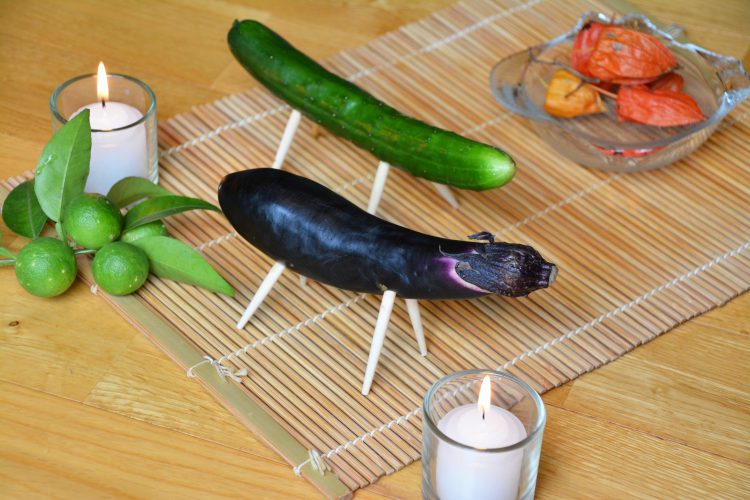
お盆の間は、ご先祖様が家族のもとへ会いに来てくれるという考え方がありますので、盆棚をつくってお迎えをする準備をします。
「まこも」という盆ゴザを敷き、その上にお供え物を飾ります。お供え物は、お野菜や果物などの水分を多く含むものや、故人が好きだったものが良いとされています。
そしてキュウリやナスを使って、「精霊馬」「精霊牛」と呼ばれるご先祖様の乗り物をつくります。
これは、ご先祖様は馬や牛に乗ってこの世とあの世を行ったり来たりすると信じられているからです。
ご先祖様がこの世に降りて来るときは、キュウリの馬で早く家にたどり着いて欲しい、あの世へ帰るときは、ナスの牛にお供え物をたくさん積んでゆっくり帰って欲しい、という願いが込められているのだそうです。
Based on the traditional saying that ancestors come on a horse and leave on a cow, a horse and cow made from cucumber and eggplant are displayed.
(先祖は馬に乗って訪れ、牛に乗って帰っていくという伝承に基づき、キュウリとナスでつくった馬と牛を飾ります。)
A staple of Obon, the cucumber horse and eggplant cow are called “shōryōma,” representing conveyances for ancestors to use to come back home and then back to their world.
(お盆の定番であるキュウリの馬とナスの牛は「精霊馬」と呼ばれ、先祖が家を訪れるときと向こうの世界へ帰るときの乗り物を表しています。)
The cucumber, which represents a quick-footed horse, helps the spirits of ancestors return home quickly.
(キュウリは足の速い馬を表し、先祖ができるだけ家に早く帰ることを助けます。)
The eggplant, which signifies a slow and big cow, enables ancestors to leisurely return to their world with a lot of offerings.
(ナスはゆっくりとした大きな牛を表し、先祖がたくさんのお供え物を積んでのんびりと向こうの世界へ帰ることを可能にします。)
・きゅうり:cucumber
・ナス:eggplant
・enable A to do:A が〜することを可能にする
お彼岸 / Ohigan

お彼岸とは、昼と夜の長さがほぼ同じになる、「春分の日と秋分の日の前後3日間」を指しており、7日間が年2回あります。いずれもその年によって変動しますが、春分の日は毎年3月21日頃で、秋分の日は9月23日頃に訪れます。
また「彼岸」とは、「あの世」のことで、仏教でいう「極楽浄土」も意味しています。
春分の日も秋分の日も、太陽が真東から昇り、極楽浄土があるとされている真西に沈むため、「あの世(彼岸)とこの世(此岸:しがん)が最も近づく日」とされており、つまり「お彼岸」とは、向こう岸にいるご先祖様や故人の霊に祈り、供養するということなのです。
行事としての「お彼岸」はインドや中国にはありませんが、日本古来の太陽信仰や祖先崇拝が起源ではないかといわれています。
古代の人々は、水平線の彼方の太陽に、極楽浄土を夢見たことでしょう。
Ohigan is a Buddhist holiday celebrated in Japan during both the Spring and Autumnal Equinox and lasts one week.
(彼岸とは、日本における仏教の休日で、春分の日と秋分の日に一週間続きます。)
Ohigan is the day on which the length of the day and night are almost equal.
(彼岸とは、昼と夜の長さがほぼ同じになる日のことです。)
Ohigan represents the state of enlightenment or the Buddhist Pure Land.
(お彼岸は、悟りの境地や極楽浄土を意味します。)
In Buddhist terms, higan refers to “the other world,” which means that, while this side is the world of the living, the other side is the world of the dead.
(仏教用語で、彼岸は「あの世」を指し、こちら側が生ける者の世界であるのに対し、向こう側が死せる者の世界であることを意味します。)
In order to comfort the spirits of ancestors on the other side, families pay visits to graves during Ohigan.
(向こう側の先祖の霊を慰めるために、お彼岸には家族でお墓参りをします。)
おはぎとぼたもち / Ohagi and Botamochi
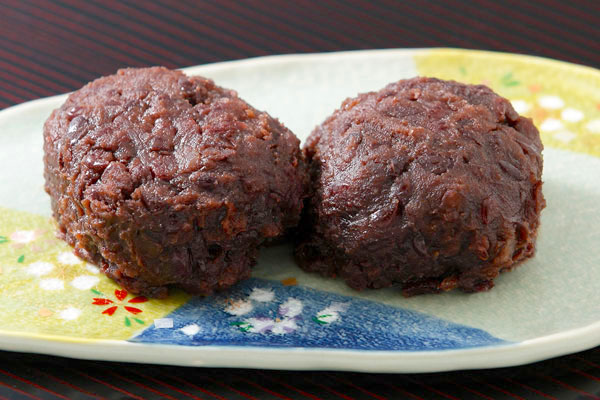
おはぎとは、餅米とうるち米を半々にして炊いたものを軽くつぶして丸め、あんこで包んだりきなこをまぶした日本の伝統的なお菓子です。
昔はお彼岸のお供え物として各家庭で手作りされていたそうですが、今では一般的な和菓子のひとつとなっています。
春のお彼岸では、春に咲く牡丹から「ぼたもち」、秋のお彼岸では、秋に咲く萩から「おはぎ」と呼ばれます。
日本では古くから、祭事などにお赤飯や紅白まんじゅうなどが用いられていることからも分かるように、小豆の「赤」という色は大変縁起が良く、厄除けの効果もあると信じられていました。
お彼岸におはぎやぼたもちが捧げられてきたのは、こうした「邪気を祓い、ご先祖様の霊を慰める」という願いが込められていたのです。
さておはぎの英語表現ですが、簡単に「あんこ、きなこ、黒すりごまなどで包んだお餅」と説明すると以下のようになります。
- rice cake covered with red bean paste
- sticky rice cake coated in smashed sweet adzuki beans
- rice ball coated with sweetened red bean paste, soybean flour or black sesame powder
Ohagi is a traditional Japanese confection made from boiled glutinous rice and red bean paste.
(おはぎは日本の伝統的なお菓子で、炊いた餅米とあんこでつくります。)
In general, people call this sweet “botamochi” during the higan of spring and “ohagi” during the higan of autumn.
(一般的に、春のお彼岸は「ぼたもち」、秋のお彼岸は「おはぎ」と呼ばれています。)
In spring, people offer “botamochi,” and in fall/autumn people offer “ohagi.”
(春には「ぼたもち」、秋には「おはぎ」をお供えします。)
Botamochi and ohagi are the same sweets but with different names.
(ぼたもちとおはぎは呼び名が異なるだけで、同じお菓子です。)
Botamochi is named from spring flower “Botan” which is a Japanese peony.
(ぼたもちは春のお花である牡丹にちなんでいます。)
Ohagi is named after the autumn flower Hagi which is a Japanese bush clover.
(おはぎは秋のお花である萩にちなんでいます。)
Ohagi is made by mixing together and cooking glutinous and non-glutinous rice, lightly mashing and molding them into balls, which are covered with red bean paste, soybean flour, or black sesame powder.
(おはぎは、餅米とうるち米を混ぜて炊き、軽くつぶして丸めたものを、あんこで包んだりきなこや黒すりごまなどをまぶしてつくります。)
Since ancient times in Japan, red adzuki beans have been thought to be an auspicious food that wards off evil spirits and invites happiness.
(日本では古くから、小豆は邪気を祓い幸運を呼び込む縁起の良い食べ物とされてきました。)
最後に
いかがでしたでしょうか。
皆さんにも馴染み深いお盆とお彼岸についてご紹介してまいりましたが、どんな小さなものにも歴史が積み上げてきた意味があることを考えると興味深いですね。
国が違えば宗教や死生観も違い、お墓参りが一般的ではない国も多くありますが、「死者を弔う」「先祖を敬う」という意識はどの民族にも存在していますので、海外の方に日本の伝統行事を伝えるうえで、ご参考になれば幸いです。
